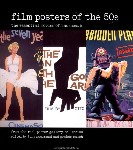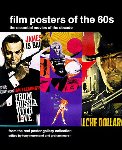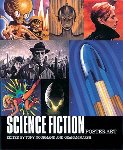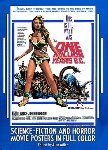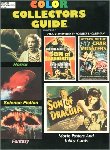|
Even though I don’t have much of a head for science, and even though
I agree with the field’s chief literary critic, Damon Knight, that
“we have no negative knowledge” (meaning that we aren’t yet in a
position to identify time travel as either science or non-science),
I’d still maintain that the differences between science fiction and
fantasy are important. (For Damon Knight’s criticism, see his superb
though sadly long out-of-print collection
In
Search of Wonder.) Important enough, in any case, to make a list of favorite neglected SF movies distinct and separate from a list of
neglected fantasy movies. So consider the following selection the
first half of a two-part series.
French people tend to conflate SF and fantasy a little more readily
than others do into a looser category known as fantastique which
also manages to encompass Surrealism, some forms of satire and
horror, comic strips, comic books, and graphic novels, among other
things. But for the purposes of this particular exercise, credible
extrapolations or fictions that at least pretend to have some
relation to science—-by which I mean
Charlie and the Chocolate
Factory (admittedly a borderline case),
The Nutty Professor, and
The
Incredible Shrinking Man, but not
Pandora and the Flying Dutchman,
The Tiger of Eschnapur, or
Eyes Wide Shut—-qualify as science
fiction. I’m also including social satires like Privilege (or
Alphaville--the supreme example, though not exactly neglected) that
toss various pop references into the mix, but not outright political
cartoons like
Dr. Strangelove and William Klein’s
Mr. Freedom. I’ve
also opted for relegating horror in most of its guises to fantasy,
with the sole exception of
The Nutty Professor. I realize there’s
something highly idiosyncratic and arbitrary about all this, but I
should stress that I’m proposing offbeat selections here, not
necessarily nominations for official classics.
Two more areas of exclusion: I have a somewhat unfashionable
preference for good movies over bad ones, despite the fact that more
fan magazines nowadays seem devoted to the latter than to the
former. This doesn’t mean I’m immune to the charms of camp; if I had
to choose between any Flash Gordon serial and any Star Wars movie,
the serial would win hands down. But since I also tend to regard
Sergei Eisenstein’s
Ivan the Terrible as the greatest
Flash Gordon
serial ever made, I’m happier when it’s the good stuff that’s going
over the top. And for similar reasons, I’ve also avoided movies with
awesome individual shots or sets or sequences, such as Just Imagine
(1930) and
This Island Earth (1954), if the rest of what one sees
doesn’t live up to them. (If practically all the shots are awesome,
as is the case with
Zardoz, I’m more prone to put up with campy
content.) One final point: the first two and last two selections on
my list are all films I regard as major, and the same goes for
The Nutty Professor; the remaining five are exciting, but not on the
same level.
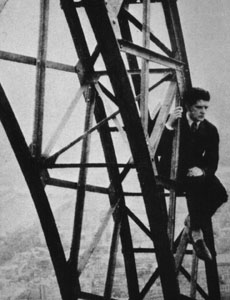 |
1)
Paris qui dort/The Crazy Ray
(René Clair, 1925). Clair’s second film
after his 1924 Entr’acte (a dada effort designed as part of a
ballet) is far from being the first SF movie. (At the very least,
it’s preceded by Abel Gance’s six-minute 1915 La Folie de Docteur
Tube and Yakov Protazanov’s far more elaborate 1924 Soviet
production
Aelita, with futurist sets and a few scenes set on Mars.)
But this poetic comedy is special in the way it ties its SF premise
to what movies can do, such as freeze or speed up the action.
The Eiffel Tower’s night watchman awakes one morning to discover
that all of Paris has frozen in its tracks, and an airplane’s pilot
and passengers land and make the same discovery—-that everything
came to a standstill at 3:25 am, including the clocks. The hero and
the others then go on a drunken spree that lasts four days, enjoying
their freedom to break into houses and go into nightclubs without
paying. Eventually, after becoming bored, they discover that a
professor, the uncle of one of the passengers, immobilized the city
with a crazy ray, at which point they get him to start things up
again. |
A certain amount of restopping, restarting, and speeding up the life
of Paris follows.
Originally about an hour long, this was
re-edited by Clair into a brisk 35 minutes in the 1950s, and this is
the version available as an extra on the Criterion DVD of Clair’s
first sound feature, the engaging Under the Roofs of Paris (1930),
which features the same lead actor, Albert Préjean.
|
2)
Metropolis
(1927). Ever since H.G. Wells called Fritz Lang’s
gigantic UFA superproduction silly, others have tended to follow
suit, including Lang himself. The movie’s final scene unquestionably
qualifies as over the top, and the same could undoubtedly be said of
certain other parts of the film as well. But however hokey this
pseudo-Marxist vision of a future city might be, the Freudian
subtexts of the original version—-before Paramount Pictures, the
American distributor, started editing out entire subplots and
obscuring some portions that remained--are surprisingly dense and
sophisticated. Not all of the original film survives today, but the
superb restoration overseen by Martin Koerber, using stills and
intertitles to represent the missing pieces, finally makes the full
design of Lang and his wife and cowriter Thea von Harbou clear, and
it’s a revelation. (See Tom Gunning’s 2000 book
The Films of Fritz Lang: Allegories of Vision and
Modernity for an intricate unpacking of the film
as an allegory and how this aspect has tended to taint
most critical appraisals of it; |
 |
Gunning’s treatment of the clashes
between Gothic and modern imagery and the way they tend to displace
the conflict between classes in the film is especially insightful.)
In fact, I’d argue that Metropolis, set in the 21st century, looks
less dated and seems more relevant to 2006 than
2001: A Space
Odyssey—-an irrefutable classic in other respects that I’ve omitted
from this list only because, like such 50s classics as
The Day the
Earth Stood Still,
Forbidden Planet, the original
Invasion of the
Body Snatchers, and
The
Incredible Shrinking Man, it qualifies today
as neither neglected nor underrated. (I suppose it could be argued
that
Metropolis isn’t neglected either, but I would counter that the Koerber restoration is.) No less tellingly, the robot Maria in
Lang’s masterpiece anticipates Gigolo Joe in
A.I. (see below) in
many significant aspects.
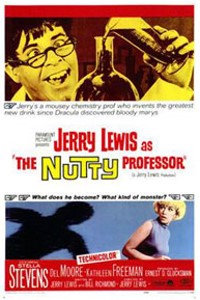 |
3)
The Nutty Professor
(1963). Yes, I know, this is almost never
classified as SF. (Neither, for that matter, is the no less
deserving 1935 James Whale masterpiece,
Bride of Frankenstein, whose
own literary source, by Mary Shelley, all but invented SF as a
literary genre.) But part of the point of this list is to stretch
the categories a little, and Jerry Lewis’s best feature, a highly
personal take on the “Dr. Jekyll and Mr. Hyde” story, is surely no
further removed from science than the space operas of George Lucas.
(Furthermore, the brightly color-coded test tubes of Professor
Julius Kelp are surely just as speculative as the Star Wars
costumes.)
It’s been argued that Lewis’s Mr. Hyde, Buddy Love, is a
reincarnation of his former partner Dean Martin, but
this is a misconception that takes some of the edge off
Lewis’s achievement. While Kelp was based on his
observation of a real-life model (according to Lewis,
someone he met on a train), Buddy Love is nothing more
or less than a caustic self-portrait of everything Lewis
finds most odious about himself.
|
And, as with Orson Welles, it
can be argued that his auto-critiques are far more devastating than
anything that could be said by his detractors. Even more striking is
this film’s pessimistic and sorrowful conclusion—-that everyone,
including Stella Stevens’ character and us, prefers the greasy and
aggressive braggadocio of Love to the gentle and klutzy fumblings of
Kelp.
|
4)
The Damned
(1963). Released the same year as Lewis’s masterpiece but
made two years earlier—-and retitled These Are the Damned by its
U.S. distributor—-Joseph Losey’s only SF film, strikingly shot in
black and white ‘Scope, is no less bleak in its estimation of
mankind, either in the present or the foreseeable future.
Unavailable today on DVD apart from an ugly and pirated pan-and-scan
version, this enduring and topical curiosity deserves much wider
circulation.
Adapted by Jamaican writer Evan Jones from H.L. Lawrence’s novel
The
Children of Light, it was the first of four kinky features that
Jones wrote for Losey (to be swiftly followed by
Eva,
King &
Country, and
Modesty Blaise), and its strangely |
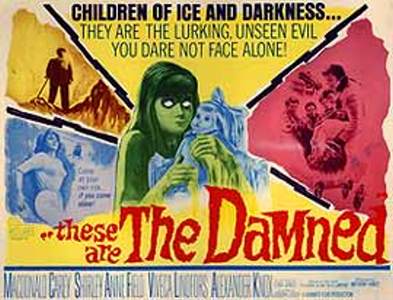 |
twisted action-thriller plot gradually registers as a ringing
indictment of nothing less than western civilization.
Starting off with a
hectoring rock song called “Black Leather,” it follows the
adventures of an American tourist (Macdonald Carey) in an English
coastal town who gets beaten by Teddy Boys after the gang leader
(Oliver Reed) uses his own sexy sister (Sally Ann Field) as bait.
She subsequently flees from her incestuously hung-up sibling, hiding
out with the American on his boat and in the seaside studio of a
local sculptor (Viveca Lindfors). As the brother continues his
pursuit, they stumble into an underground bunker housing radioactive
children who are raised and monitored via closed-circuit TV--the
victims of a military experiment conducted by the sculptor’s lover
(Alexander Knox) that’s designed to enable the kids to survive a
nuclear holocaust. Apart from the bland American, everyone’s a wild
card in this bitter parable. (Lindfors’ sympathetic character is
especially interesting.)
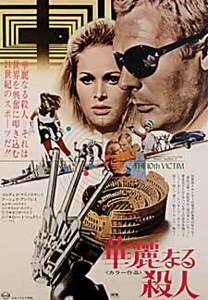 |
5)
The 10th Victim
(1965). Elio Petri’s cynical, glitzy, violent and
poker-faced pop Italian comedy, set in the 21st century, squares off
Marcello Mastroianni in a blond wig with Ursula Andress in a
protracted erotic skirmish.
The Robert Sheckley story it derives
from, “The Seventh Victim”—-which I presume was renamed to avoid
confusion with Val
Lewton’s 1943 masterpiece chiller—-is
similarly set in a future in which war has been
abolished, and international government-sponsored
“hunts” with extensive media coverage are designed to
work off human aggression. Each participant signs up for
ten hunts—-half as hunter, half as potential victim—-and
whoever succeeds and survives all ten becomes the member
of a prestigious club. A male hunter on his seventh hunt falls in love with his
female prey on her tenth outing, and he winds up doomed by his
infatuation. The movie reverses this setup—-Andress is the hunter on
her tenth round; Mastroianni is the hunted on his seventh—-and the
tone’s far too facetious to allow for love. |
After a prologue in
which Andress performs her ninth kill by spraying bullets from her
brassiere in a joint called the Masoch Club, the scene shifts from
New York (where the original story was set) to Rome, where she and a
seemingly bored Mastroianni stage their seductive confrontations in
settings charged with satiric, high-tech details. According to
critic Manny Farber, “in certain nonplot scene” the movie “comes
close to the perfumed eroticism that is always promised in painting
by Rothko or Jasper Johns but never delivered.” In other words, you
might say it’s too stylish for words.
|
6)
Privilege
(1967). Peter Watkins is the supreme master and very
nearly the inventor of the pseudo-documentary, which he uses as an
unorthodox way of recounting history or projecting contemporary
trends into the near-future. This dystopian Universal release is
about the fascist takeover of Great Britain, with a duped and
manipulated messianic rock singer (Paul Jones, lead singer of
Manfred Mann in his first film role) used as a political as well as
marketing tool. This comes from Watkins’ greatest period to date,
which also produced
Culloden (1964) and
The War Game (1965). The
latter two films have recently been issued on DVD, and so have the
subsequently made
The Gladiators (1969) and
Punishment Park
(1971)—-both of which, along with
The War Game, also qualify as SF,
so a long-overdue rediscovery of early Watkins is already in
progress. I therefore assume that the only thing preventing us so
far from having this ferocious satire on DVD is the fact that,
unlike the others, it was released by a major Hollywood studio—-and
didn’t fare well at the boxoffice in 1967, when the public wasn’t
ready for it Let’s hope that some enlightened Universal executive
realizes that it’s hour has finally come and does something about
it. |
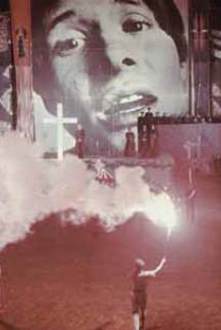 |
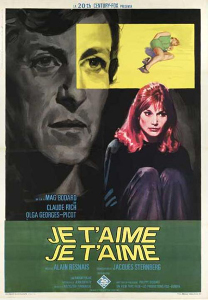 |
7)
Je t’aime, je t’aime
(1968). Alain Resnais’ time-travel feature—-a
major influence and inspiration on
Eternal Sunshine of the Spotless
Mind, but unfortunately the only Resnais feature apart from the
exquisite Providence that’s still unavailable on DVD—-confounds the
most common American criticism of him, virtually copyrighted by
Pauline Kael, that his films are cold, cerebral technical exercises.
In fact, Kael had it backwards. This poignant story about a failed
suicide who’s sent into his past as a scientific experiment that
goes awry—-so that he’s hurtled through an achronological mosaic of
fragments from his life, sometimes getting stuck in repetitive,
arbitrary moments, while taking us along with him on the bumpy
ride—-is full of intensely passionate and melancholy feelings, as
the film’s very title (“I Love You, I Love You”) suggests. But when
it comes to the film dealing with the scientific and technical side
of time travel, it’s awkward and unconvincing. |
One reason for this discrepancy can be traced back to this film’s
relation to fantastique. The screenwriter, Jacques Sternberg, is a
Surrealist, and Resnais got him to write hundreds of pages of
“automatic writing” that the director then spent years editing into
a script, depending on his own unconscious mind and instincts as
well as Sternberg’s to furnish the story’s strong emotional content,
and meanwhile treated the scientific basis for time travel as a kind
of whimsical joke.
|
8)
Zardoz
(1974). Speaking of Kael, she made a lot of sport out of
ridiculing John Boorman’s ambitious SF epic
when it came out, overlooking its own traces of irony (such as its
references to
The Wizard of Oz) to concentrate on its high-flown
intellectual pretensions. I suppose she had a point, but considering
how beautifully and masterfully Boorman manages to fill all his
CinemaScope frames, it’s a point that can be harped on only at the
expense of overlooking that this film’s brilliance and its absurdity
are really opposite sides of the same coin. Theoretically, one could
make the same sort of criticism of the delirious crazy-house mirror
shootout at the end of Orson Welles’
The Lady from Shanghai—-a
sequence Boorman evokes in
Zardoz. But one would miss out on all the
fun in the process. In the year 2293, most of the world, now
polluted
and infertile, is ruled by a flying stone godhead with a voice named
Zardoz, secretly controlled by a wizard. Zed (Sean Connery), one of
the warriors carried around by
Zardoz,
kills the wizard, lands on earth, and stumbles upon the
Vortex, a 300-year-old elite commune of immortals
preserving the world’s knowledge, which proceeds to
study this primitive for research with the intention of
killing him afterwards, until he stages a rebellion.
|
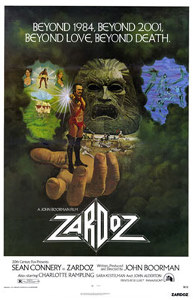 |
This is a very simplified
synopsis of an extremely complicated plot that also involves
Charlotte Rampling as an immortal. Perhaps a better summary would be
to compare Zardoz to Boorman’s best film--his 1967
Point Blank--and
note that both films could be called Tarzan versus IBM, Godard’s
original title for
Alphaville (with Lee Marvin taking over the
Tarzan role in the earlier film). Both chart the fool’s progress of
primitive heroes working their way up mysterious pyramids of power,
only to discover an ineffectual clown like
the Wizard of Oz
at the
top. This isn’t the whole of
Zardoz, to be sure, but at least it
suggests that Boorman spices his own deep-dish musings with an
occasional grain of salt.
 |
9)
Stalker
(1979). There are few such ironies in Andrei Tarkovsky’s
free and very great adaptation of Arkady and Boris Sturgatsky’s
dystopian novel
Roadside Picnic. But one that does crop up
unexpectedly figures as one of the only genuine, laugh-out-loud gags
in all of Tarkovsky’s work. After a scientist and writer accompany a
guide, the title character, through the better part of this
slow-moving, 152-minute epic, traipsing endlessly through a
poisonous and dangerous wasteland to arrive at the Zone--a
mysterious room that is said to hold the power to grant their
deepest wishes—-they arrive at this decrepit, abandoned location
only to hear a phone ringing inside. As an artist, Tarkovsky himself
hated the very notion of science fiction; according to
him, his previous and only other foray into the genre,
Solaris (1972), failed because it was too much
like SF. (On other occasions, he objected even to the
notion of movie genres, arguing that film itself was
already a genre in its own right.) I don’t believe he
objected to
Stalker on the same grounds, but it must be
admitted that his trancelike and highly spiritual
narrative is so adept at creating its own rules of form,
narrative, and meaning, that SF serves more as a gateway
into its manifold riches than as a final destination. |
To ‘fess up, the first time I saw this film, my dashed expectations
about SF in general and the Zone in particular made me livid for
most of the running time, and I stuck around more out of morbid
curiosity than for any other reason. But by the end I started to
realize that my dashed expectations were the precise subject of the
film, and what Tarkovsky had to teach me about this subject is still
reverberating.
|
10)
A.I. Artificial Intelligence
(2001). Unlike most of my friends and
colleagues, I’ve treasured this bittersweet SF remake of
Pinocchio—-the tragic yet happy tale of a robot who winds up
expressing the final breath of mankind--since the first time I saw
it. It held me spellbound from first frame to last, and frankly,
through all my subsequent viewings, it continues to move and speak
to me more than any feature I’ve seen since. So those who say that
it should have ended a few scenes earlier or that the bits with
Gigolo Joe (Jude Law) are the best parts might as well be speaking
to me in a foreign tongue. And those who approach this movie from an auteurist perspective--viewing it simply as either a Stanley Kubrick
film (because he spent years developing it) or as a Steven Spielberg
film (because he took over the project after Kubrick’s death, at the
request of Kubrick’s family)—-can’t be viewing it correctly
either.
As a philosophical meditation on the differences between mechanical
and organic life, life and death, and mankind and the artifacts of
mankind, we can’t even say with confidence if
A.I. is the product of
a dead filmmaker or a living one, a piece of celluloid or an
experience, a warm tearjerker of Disneylike goo about the goodness
of human life or the chilliest and bleakest possible
parable about its futility. |
 |
It’s sad to reflect that out of my ten selections
here, only the first on my list, The Crazy Ray, has much chance of
cheering you up as a happy sort of fantasy, which probably reflects
my current feelings about the times we’re living in. (I think we can
all agree that the happy ending of
Metropolis is by far the silliest
thing about the movie.) But I also have to admit that, for all its
terminal gloom about the human condition and the future of mankind,
A.I.
can only fill me with hope about the future of art. |
![]()
![]()
![]()
![]()












